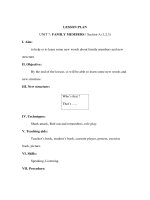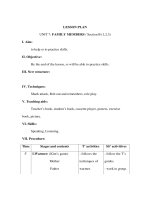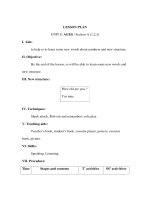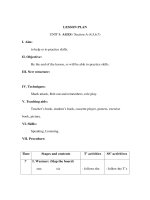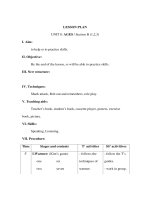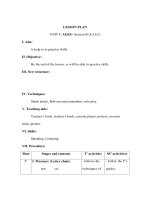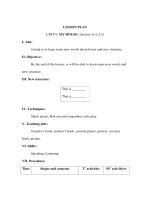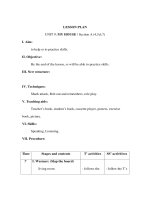- Trang chủ >>
- Mầm non - Tiểu học >>
- Lớp 2
Global Success_Grade 2_Lesson plan Unit 13_Giáo án Unit 13
Bạn đang xem bản rút gọn của tài liệu. Xem và tải ngay bản đầy đủ của tài liệu tại đây (73 KB, 14 trang )
TIẾNG ANH 2
LESSON PLAN
School:
Grade:
Teacher:
____________________
____________________
____________________
School year:
Week:
Approved by:
____________________
____________________
____________________
Unit 13. In the maths class
Lesson 1 – Period 1
Date: _______________
I. OBJECTIVES
II. INPUT
By the end of the lesson, pupils will be able to:
- correctly pronounce the name of the letter N/n (/en/);
- correctly pronounce the sound of the letter N/n (/n/) in
isolation and in the words eleven, thirteen, fourteen and
fifteen.
Language:
- Sound /en/
- Vocabulary: eleven, thirteen, fourteen, fifteen
Resources/Material:
- Student’s book, p. 57
- Teacher’s guide, pp. 112-114
- hoclieu.vn
- Flashcards for Unit 13
- Poster for Unit 13
- Computer, projector
1
III. PROCEDURE
Procedure
Warm-up
Warm-up – Listen and repeat – Point and say – Fun corner
– Wrap-up
Teaching and learning activities
Classroom
management
5 minutes
Option 1
Whole class
Refresh pupils’ memory of the numbers they
learnt in Tieng Anh 1 by having them count
from one to ten.
Option 2
Whole class
Refresh pupils’ memory of the previous unit by
having them sing the song from Unit 12, Lesson
3.
Option 3
Whole class
Introduce the topic of the new unit by showing
pictures of different classroom items, e.g. pens,
pencils, rulers, and have pupils count how many
there are. Write the correct numbers on the
board in both numerical and word form, e.g. 2
(two).
1. Listen and repeat. 10 minutes
Step 1: Draw pupils’ attention to the picture (say “Look Whole class
at the picture.”). Ask questions to help them
identify the context (The picture shows a maths
class. A boy is doing sums on the board. Eleven,
thirteen, fourteen and fifteen are labelled, with
the letter n in red).
Step 2: Have pupils point to the letter N/n (say “Point Individual
to the letter N.”). Explain that the name of the work
letter N/n is different to its sound (say “Listen. /
en/ /n/.”).
Step 3: Play the recording of the name and sound of Whole class/
the letter N/n and encourage pupils to repeat Individual
2
(say “Listen and repeat.”). Do this several times, work
with pupils repeating both individually and in
chorus. Correct their pronunciation if
necessary, and praise them when their
pronunciation is good.
Step 4: Have pupils look at the number 11 (say “Look at Individual
the number eleven.”) Then have them point to work
the word eleven (say “Point to the word
eleven.”). Draw their attention to the colour of
the letter n (say “Look at the colour of the letter
n. It is red.”).
Step 5: Play the recording of eleven and encourage Whole class/
pupils to repeat (say “Listen and repeat.”). Do Individual
this several times, with pupils repeating both work
individually and in chorus. Correct their
pronunciation if necessary, and praise them
when their pronunciation is good.
Step 6: Repeat Steps 4 and 5 for thirteen, fourteen and Whole class/
fifteen.
Individual
work
Step 7: Play the recording in full and encourage pupils
to repeat the name and sound of the letter N/n,
eleven, thirteen, fourteen and fifteen both
individually and in chorus.
Extension: For better pupils, using the new and learnt in
Tieng Anh 1 numbers and have the pupils
make labels for the numbers. Ask them to
attach the cards to the corresponding
numbers and practise saying the words.
Whole class/
Individual
work
Group work
2. Point and say. 7 minutes
Step 1: Have pupils point to the letter N/n and correctly Whole class
pronounce its name and sound (say “Point to
the letter N. Say /en/. Now say /n/.”).
Step 2: Have pupils point to and correctly pronounce Whole class/
eleven (say “Point to eleven. Say eleven.”). Do Individual
this several times, with pupils repeating both work
3
individually and in chorus. Correct their
pronunciation if necessary, and praise them
when their pronunciation is good.
Step 3: Repeat Step 2 for thirteen, fourteen and fifteen.
Whole class/
Individual
work
Step 4: Put pupils into pairs or groups for further Group work/
practice of Steps 1 to 3. Go around the class to Pair work
offer help or correct pupils’ pronunciation, if
necessary.
Fun corner: Number race 8 minutes
Step 1: Divide the class into four teams. Have each Group work
team form a line in front of the board.
Step 2: Write four different numbers on the board. Group work
Explain that when you call out a number, the
pupil at the front of each line must race to
touch the correct number. The first pupil to
touch the correct number scores one point.
Step 3: Before the next turn, erase the number you just Group work
called out and replace it with a different
number.
Step 4: Play the game. The team with the most points Group work
wins.
Wrap-up: 5 minutes
Revise the main teaching point of the lesson: Whole class
the sound of the letter n and the words eleven,
thirteen, fourteen, fifteen.
Option 1
Whole class
Using hoclieu.vn, have pupils look at the
numbers in the picture and repeat the words
after the recording.
Option 2
Individual
Using Poster for Unit 13, ask pupils to point to work
4
the numbers in the picture and say the words.
For better pupils, teacher may cover the words
and ask them to point to the numbers and say
the words aloud.
Option 3
Using pictures and flashcards, get some pupils
to match the words eleven, thirteen, fourteen,
fifteen and the pictures. Then ask the class to
say the words aloud. For better class, teacher
may use the numbers that pupils have learnt,
e.g. six, eight, ten.
5
Individual
work
TIẾNG ANH 2
LESSON PLAN
School:
Grade:
Teacher:
____________________
____________________
____________________
School year:
Week:
Approved by:
____________________
____________________
____________________
Unit 13. In the maths class
Lesson 2 – Period 2
Date: _______________
I. OBJECTIVES
II. INPUT
By the end of the lesson, pupils will be able to:
- correctly pronounce the sound of the letter N/n (/n/) and
the words eleven, thirteen, fourteen and fifteen in a
chant;
- recognize target words while listening;
- complete the words eleve_, thirtee_, fourtee_ and fiftee_.
Language:
- Sound /en/
- Vocabulary: eleven, thirteen, fourteen, fifteen
- Phrases/sentences with the sound /en/, the words
eleven, thirteen, fourteen, fifteen, the sentence structure
How many _____?
Resources/Material:
- Student’s book, p. 58
- hoclieu.vn
- Teacher’s guide, pp. 114-116
- Pictures or flashcards for Warm-up
- Workbook, pp. 40-41
- Computer, projector
6
III. PROCEDURE
Warm-up – Listen and chant – Listen and tick – Write and
say – Wrap-up
Procedure
Teaching and learning activities
Warm-up
5 minutes
Classroom
management
Option 1
Whole class
- Ask pupils what letter and sound they learnt in
Lesson 1 (N/n, /n/).
- Show pictures of the words that pupils learnt
in Lesson 1 (eleven, thirteen, fourteen, fifteen)
and encourage them to say the words in
chorus. More advanced classes can add other
words that end with the letter N/n.
Option 2
Group work
Ask the class to play Number race again, using
the numbers in Lesson 1, Unit 13 and the
numbers learnt in Tieng Anh 1, saying Now let
us play Number race!
Option 3
Whole class
Get pupils to play What’s Missing Game, using
the pictures and flashcards with the
incompleted words eleve_, thirtee_, fourtee_
and fiftee_. Pupils should guess the missing
letters and say the words correctly.
3. Listen and chant. 10 minutes
Step 1: Draw pupils’ attention to the picture and have Whole class
them point to the balls (say “Look at the
picture. Point to the balls.”).
Step 2: Say “How many balls?” and encourage pupils to Whole class
count and answer “Thirteen.”
Step 3: Have pupils point to the dolls (say “Point to the Whole class
dolls.”). Say “How many dolls?” and encourage
7
pupils to count and answer “Fifteen.”
Step 4: Play the recording of the chant to familiarize
pupils with the words and rhythm (say
“Listen.”)
Step 5: Have pupils point to each line of the chant (e.g.
say “Point to line one.”). Play the recording of
each line and encourage pupils to chant (say
“Listen and chant.”).
Step 6: Play the recording in full and encourage pupils
to chant (say “Listen and chant.”). Pupils can
clap along or do other actions to help them
keep the rhythm.
Step 7: Divide the class into two teams. Teams take it in
turns to chant a line. The whole class can clap
along or do other actions.
Extension: For better pupils, cover or omit some letters/
words in the chant and have them guess and
say all the lines aloud. For example:
N, n, eleven.
N, n, _____.
How many ball?
Eleven or _____?
4. Listen and tick. 7 minutes
Step 1: Have pupils look at the pictures and say the
words (say “Point and say.”). When pupils
answer correctly, confirm by saying “thirteen/
eleven/ fourteen/ fifteen”.
Step 3: Check the answers by asking “a or b?”
When pupils answer correctly, confirm by
saying “1a. Can you see the number
thirteen?”/ “2b. Can you see the number
fifteen?” and encourage them to repeat.
Whole class
Individual
work/
Whole class
Whole class
Group work
Individual
work
Whole class
Step 2: Play the recording and allow pupils time to Individual
complete the activity (say “Listen and tick.”).
work
Step 3: Play the recording again, if necessary (say Individual
“Listen again.”).
work
8
Step 4: Check the answers by asking “a or b?” When Whole class
pupils answer correctly, confirm by saying “1a.
Can you see the number thirteen?”/ “2b. Can
you see the number fifteen?” and encourage
them to repeat.
Audio script: 1. Can you see the number thirteen?
2. Can you see the number fifteen?
Answers:
1. a
2. b
5. Write and say. 8 minutes
Step 1: Write the letter n (lower case) on the board and Whole class
say “n” (/en/).
Step 2: Write the letter n (lower case) on the board
again, but this time is more slowly. Invite a few
pupils to come to the front of the class and
write the letter n (lower case) on the board.
Step 3: Draw pupils’ attention to the picture and labels
(say “Look and write.”). Allow pupils time to
complete the activity. Go around the class to
offer support and feedback.
Step 4: Have pupils say the words (say “Say the
words.”).
Extension: - For weaker pupils, have them do Activity 3,
Unit 13 in their workbooks.
- For better pupils, have them do Activity 4,
Unit 13 in their workbooks.
Wrap-up
Individual
work
Whole class/
Individual
work
Whole class
Individual
work
5 minutes
Option 1
Have pupils listen to the recording, then say
the chant again.
Whole class
Option 2
Ask pupils to look at the pictures in 4. Listen
and circle and say about them, e.g. thirteen,
eleven, ... Encourage better pupils to use
learnt structures e.g. That’s thirteen.; I can
Whole class
9
see number eleven.; ...
Option 3
To reinforce the vocabulary, get pupils to do
Activity 1, Unit 13 in their workbooks.
10
Individual
work
TIẾNG ANH 2
LESSON PLAN
School:
Grade:
Teacher:
____________________
____________________
____________________
School year: ____________________
Week:
____________________
Approved by: ____________________
Unit 13. In the maths class
Lesson 3 – Period 3
Date: _______________
I. OBJECTIVES
II. INPUT
By the end of the lesson, pupils will be able to:
- use the sentence structures What number is it? and It’s
_____. to ask and answer questions about numbers.
- sing a song with the sentence structures What number is
it? and It’s _____.
Language:
- What number is it? It’s _____.
Resources/Material:
- Student’s book, p. 59
- hoclieu.vn
- Teacher’s guide, pp. 116-118
- Workbook, p. 42
- Computer, projector
11
III. PROCEDURE
Procedure
Warm-up
Warm-up – Listen and repeat – Let’s talk – Let’s sing –
Wrap-up
Teaching and learning activities
Classroom
management
5 minutes
Option 1
- Have pupils listen to the recording, then sing Whole class/
the chant on page 58.
Individual
- Select some better pupils to sing the chant in work
front of class. The class listens to them and claps
hands along.
Option 2
Individual
- Invite one or two pupils to write the letter N/n work
on the board.
- Get pupils to say numbers that contain the
sound of the letter N/n from Lessons 1 & 2 and
the learnt units.
Option 3
Individual
Have pupils ask and answer about quantity work
using How many ______? and things in the
classroom.
6. Listen and repeat. 5 minutes
Step 1: Draw pupils’ attention to the picture (say “Look
at the picture.”). Say “What number is it?” –“It’s
eleven.”; “What number is it?” – “It’s twelve.”
Step 2: Have pupils point to the sentences (say “Point
to the sentences.”).
Whole class
Individual
work
Step 3: Play the recording and encourage pupils to Whole class
repeat (say “Listen and repeat.”).
Step 4: Do this several times, with pupils repeating both Whole class/
individually and in chorus. Correct their Individual
pronunciation if necessary, and praise them work
12
when their pronunciation is good.
7. Let’s talk.
10 minutes
Step 1: Write What number is it? and It’s _____. on the Whole class
board.
Step 2: Write the number 11 on the board. Say “What Whole class
number is it?” and encourage pupils to answer
using the full sentence structure. When they
answer correctly, confirm by writing eleven in
the gap.
Step 3: Draw pupils’ attention to Picture a (say “Look at Whole class
Picture a.”). Say “What number is it?” and
encourage them to say “It’s twelve.” both
individually and in chorus. Correct their
pronunciation if necessary, and praise them
when their pronunciation is good.
Step 4: Repeat Step 3 for Pictures b, c and d.
Whole class
Step 5: Put pupils into pairs to practise asking and Whole class/
answering questions about the numbers.
Individual
Go around the class to offer help or correct work
pupils’ pronunciation, if necessary.
Extension: 1. Invite some pupils to point to the pictures Whole class
and act out the exchanges in front of the class.
2. Have pupils play Bingo, using numbers in
Unit 13 and those learnt in Tieng Anh 1.
8. Let’s sing. 10 minutes
Step 1: Draw pupils’ attention to the picture (say “Look Whole class
at the picture.”). Say “What number is it?” and
encourage pupils to answer using the full
sentence structure.
Step 2: Play the recording of the song to familiarize Whole class
pupils with the rhythm and melody (say
“Listen.”).
13
Step 3: Read the song line by line and encourage pupils
to repeat (say “Listen and repeat.”). Do this
several times, with pupils repeating both
individually and in chorus. Correct their
pronunciation if necessary, and praise them
when their pronunciation is good.
Step 4: Say “Let’s sing!”. Play the recording line by line
and encourage pupils to sing along.
Whole class
Individual
work
Whole class
Step 5: Have pupils work in groups to make up actions Group work
for the song. Invite a few groups to perform the
song for the class.
Wrap-up
5 minutes
Revise the main teaching point of the lesson: Whole class
the structures What number is it? and It’s
_____. to ask and answer questions about
numbers.
Option 1: Get pupils to write/ draw/ colour Group work
numbers 11-15, then label them and show to
the class.
Option 2: Have pupils do Activity 6, Unit 13 in
Individual
their workbooks.
work
Option 3: Show pupils the lyrics of the song with Individual
some missing words, e.g.:
work
What number is it?
Eleven, twelve or _______?
It’s thirteen.
What number is it?
Thirteen, fourteen or _______?
It’s fifteen.
Then ask some advanced pupils to guess the
missing words and sing the complete song
aloud.
14
